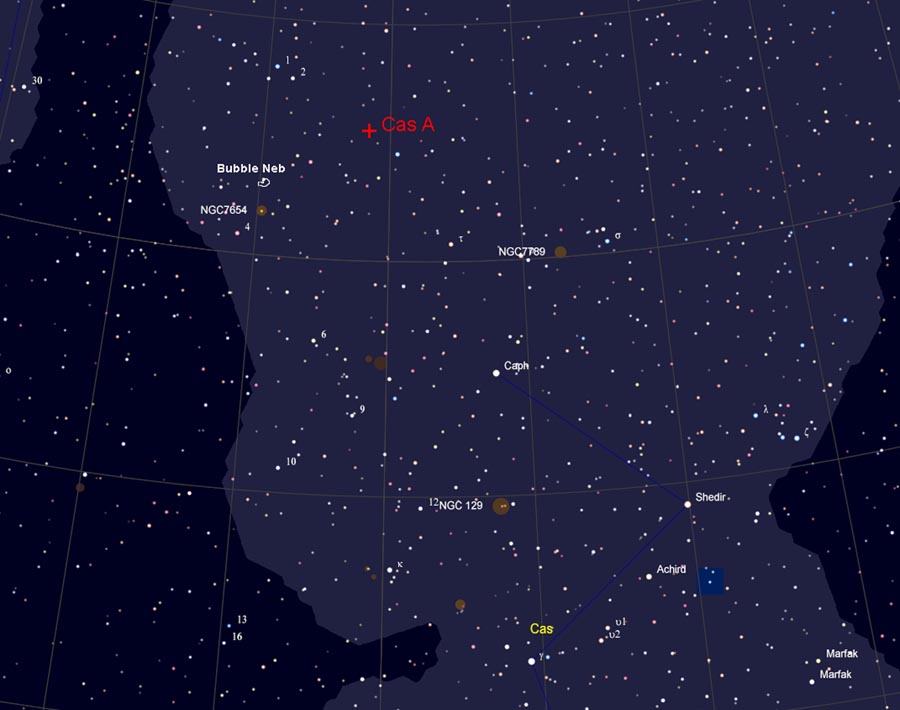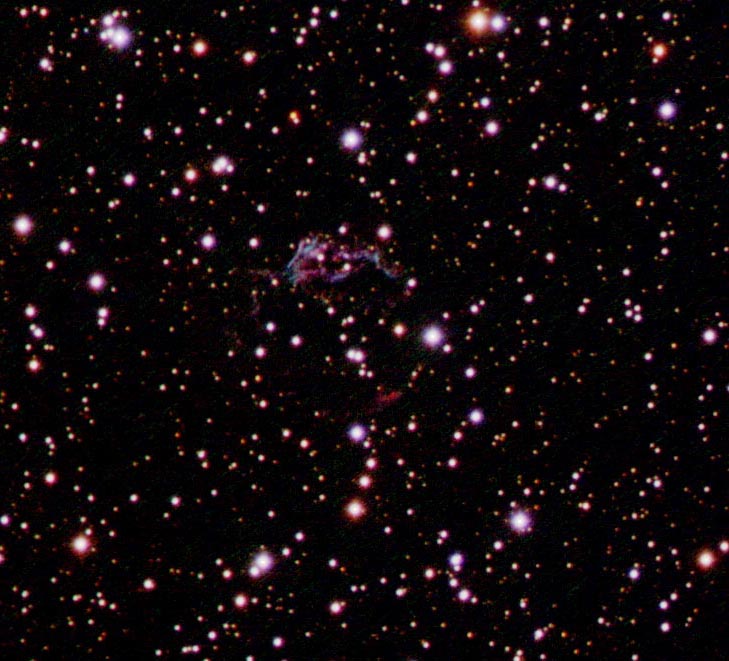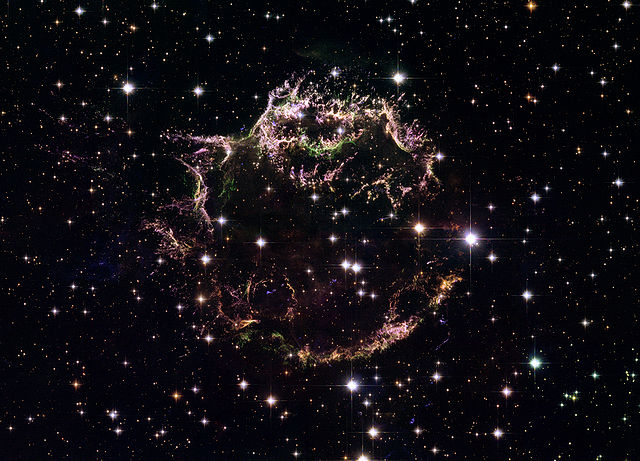
 | SOCO Blog |
17 October 2015
CASSIOPIEA A
In the previous blog entry, I presented a couple of examples of planetary nebulas (the Helix Nebula and the Dumbbell Nebula). A planetary nebula is formed when a star that is around the size of our Sun runs out of hydrogen in its core and subsequently blows off its outer stellar atmosphere to form a nebula surrounding the remnant of the star. However, when the star is much larger than our Sun, a much more cataclysmic event occurs— when the star's core begins to fuse elements into iron, the star collapses and then rebounds in a titanic explosion that ejects most of the stellar material into the surrounding space. This is a supernova, and the resulting nebula is called a Supernova Remnant (SNR). In this case, the remains of the star does not survive as a white dwarf, but ends up as a neutron star or black hole.
I've previously presented my imagery of a famous SNR, the Veil Nebula in the constellation Cygnus. Supernovas are relatively rare in our galaxy, so there are not a lot for the amatuer astronomer to observe. However, an article by Howard Banich in the December 2014 issue of Sky and Telescope aroused my interest by reporting that the Cassiopeia A SNR could be observed visually with a modest-sized telescope. I wondered, "If it can be seen visually under these circumstances, maybe I can image it with the SOCO scope."
For background, the Cassiopiea A SNR is the remains of a supernova that exploded in the constellation Cassiopeia at a distance of around 11,000 LY. There is no difinitive record of anyone seeing this exploding star. The rate of expansion of the SNR suggests that it could have been visible to observers on Earth around the year 1667. It has been suggested that the British astronomer John Flamsteed may have accidently observed it when he recorded a 6th-magnitude star near the SNR location in August of 1680. Unfortunately, there is no other evidence supporting this idea. It has also been suggested that the supernova was not observed because it was shrouded by dust and gases previously ejected by the star before its final explosion. Cassiopeia A is also known as a strong radio source, which is where it gets its name (radio sources are given letters as identifiers).
The Cassiopeia A SNR is located within the stream of the Milky Way between the constellations Cepheus and Cassiopeia. The finder map in Figure 1 shows its location in eastern Cassiopeia, not far from a couple of other interesting objects, the Bubble Nebula (NGC 7635) and the open cluster NGC 7654 (M 52).

Figure 1. The location of the Cassiopeia A Supernova Remnant.
Source: Cartes du Ciel.
Since the article in Sky and Telescope, I've made several attempts to image Cassiopeia A. I initially attempted to image it last winter using a series of 90-second exposures in the red, green and blue spectral bands. These showed just a hint of the SNR, but I intended to combine these with longer exposures in the Hα, Hβ, and OIIII spectral bands. This set of images showed very little. I repeated this attempt on the 17th and 20th of September of this year, this time using 15-minute exposures for the narrow bands. Again, these images didn't reveal much— in fact, it looked like the 90-sec red, green and blue images showed more than the longer narrow-band images. So, on the 10th and 11th of October, I took a set of twenty 6-minute exposures in each of the red, green and blue spectral bands. Upon processing, this set finally revealed the object with a reseanable degree of detail. The resulting composite color image of Cassiopeia A is shown in Figure 2.

Figure 2. The Cassiopeia A Supernova Remnant.
An enlarged view of the object is presented in Figure 3. This image reveals the SNR as an incomplete shell with the primary components being a more prominent Northern Arc and a less prominent Southern Arc. This structure is similar to that of the Veil Nebula, which also reveals itself as a fragmented shell. The appearance of the object in Figure 3 is similar to that in the true-color image presented in the Sky and Telescope article (the image in the article is a bit sharper since it was made with a 12-inch scope).

Figure 3. Enlarged view of the Cassiopeia A Supernova Remnant.
Figure 4 shows a detailed (false-color) image of Cassiopeia A obtained using the Hubble Space Telescope. The fragmented nature of the expanding shell is apparent in this image, and the true extents of the Northern and Southern Arcs can be seen.

Figure 4. Hubble Space Telescope image of the Cassiopeia A Supernova Remnant.
Source: NASA and ESA.
I'm pretty much pleased with my imagery of Cassiopeia A, and I think this is about the most detail I can probably squeeze out of the SOCO telescope for this target. Future imaging will await the acquisition of a larger telescope for SOCO. Still, I'm happy to be able to pull in such a distant and enigmatic object as this. Having finally captured it (after several tries), I can now go on to the millions of other objects in the night sky.
 Return to SOCO Blog Page
Return to SOCO Blog Page
 Return to SOCO Main Page
Return to SOCO Main Page
Questions or comments? Email SOCO@cat-star.org